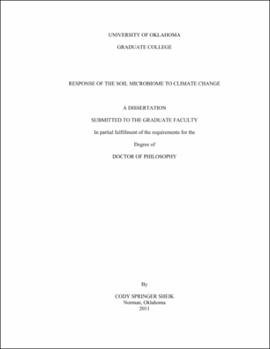| dc.description.abstract | Anthropogenically induced climate change is a multi-factor process that will likely exert significant pressure on biogeochemical cycling of important elements such as carbon and nitrogen in all environments. Central to the issue is the increasing temperature associated with the concomitant increase of atmospheric greenhouse gases. To date much work has focused on understanding the response of macro-communities, such as plants, to increasing temperature. However, little attention has been given to microorganisms despite their importance in geochemical cycling of nutrients necessary for plant growth. Thus we sought to understand the dynamics of microbial communities in tallgrass prairie located in central Oklahoma. This thesis focuses on quantifying the response to warming of three main microbial groups found in soil; Bacteria, Fungi and Archaea. Utilizing a sampling time transect that covered two growing seasons beginning in the late summer of 2004 through the spring of 2006, we were able to track microbial population abundance and diversity with quantitative PCR and pyrosequencing methods. Interestingly, beginning in the spring of 2005 the experimental warming site underwent a moderate drought that lasted up until the spring of 2006. We found that in normal precipitation years warming generally increases microbial population size. However when warming was coupled to drought, bacterial and archaeal populations decreased while fungal populations increased. The shift from ample to limited rainfall also had large impacts on bacterial diversity as many groups likely went into dormancy. Ammonia oxidizing (AO) communities were dominated by Archaea, which saw increases in population size under warming but decreased in response to drought. Interestingly, AO Bacteria responded opposite of AO Archaea by increasing in size during the drought. This work highlights the fact that microorganism populations are dynamic in soil and that under a warming climate, drought events will likely have great influence on the biogeochemical cycling of nitrogen and carbon in grassland ecosystems. | |
